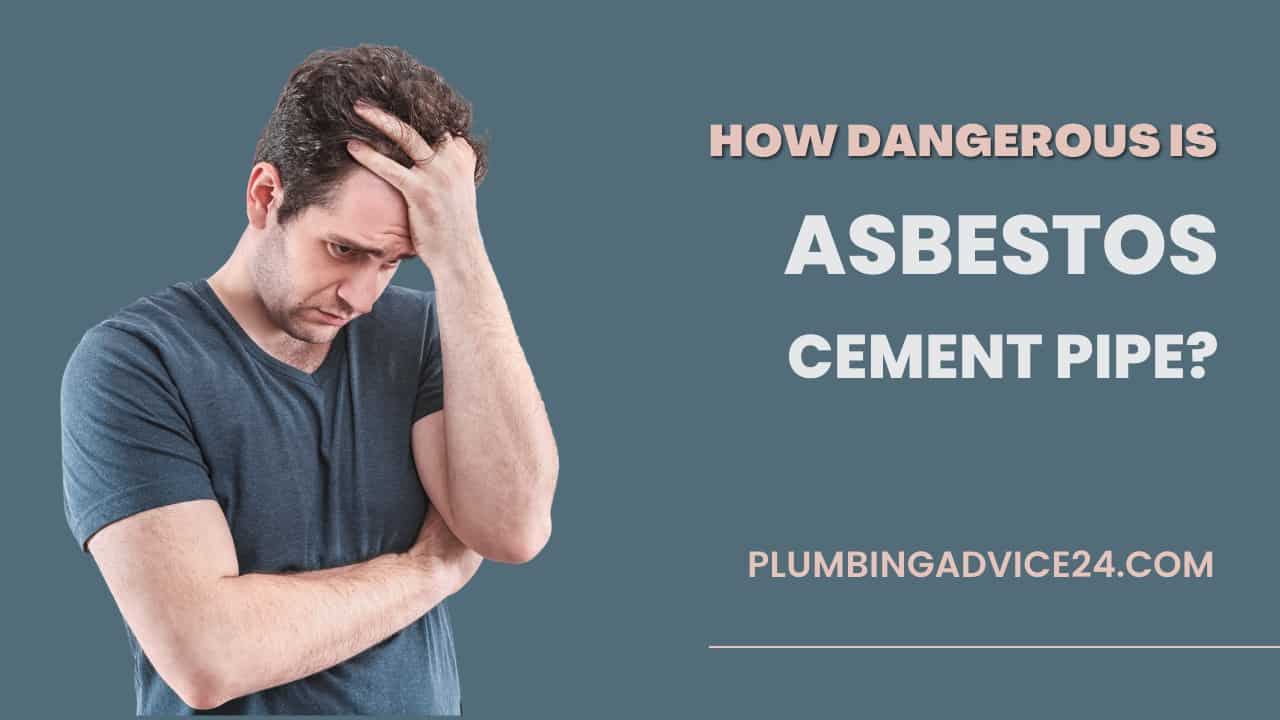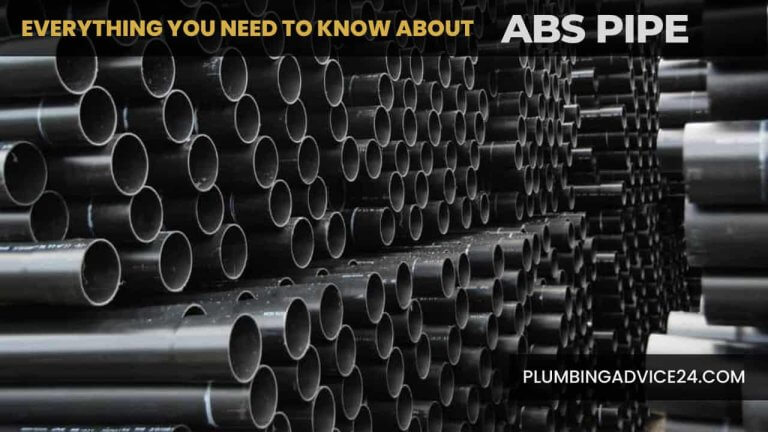How Dangerous Is Asbestos Cement Pipe
Asbestos cement pipe, also commonly known as transite pipe, was made from cement and asbestos fibers. It was highly resistant to corrosion and was widely used in drainage systems and gas lines. Government and private enterprises use asbestos cement pipes for applications such as fresh and sea water mains, gas mains, sewers, mining, agriculture, electrical cables, venting flues, etc. So let’s know more about these pies.
What Is Asbestos Cement Pipe?
Asbestos cement pipes, which are cement lines mixed with asbestos. It is a cement liquid transportation vessel that is tubular in shape. The asbestos-cement pipe was used for water supply systems in some municipalities in the US and possibly other countries until the 1970s. It is also often referred to as a transite pipe.
Asbestos cement pipe was first developed by reinforcing concrete with asbestos. These pipes were made of raw materials such as asbestos fiber, portland cement, and silica sand. Asbestos cement pipe was highly resistant to corrosion, wear, chemical and biological reactions, and extremes of temperature and humidity.
At the time, these pipelines were believed to be resistant to corrosion, making them more durable than standard cement or cast iron pipes. Most companies at that time favored asbestos cement pipes because asbestos gave the pipes greater strength, allowing them to operate at higher pressures. Also, asbestos cement pipe was cheap, durable, and easy to handle.
In the 1940s, asbestos cement pipes began to be used for potable water distribution and wastewater collection and were estimated to account for up to 20 percent of all distribution pipes. Unfortunately, in the 1970s, it was discovered that asbestos exposure could lead to serious cancers and other diseases, such as mesothelioma and asbestosis.
Because of this, the US Environmental Protection Agency (EPA) promulgated regulations to monitor asbestos levels in drinking water and issued a ban on asbestos products in 1979. By the time workers stopped using asbestos lines, 600,000 miles of them had been used.
With thousands of miles of AC (asbestos cement) pipe installed in distribution systems in the US nearing the end of their useful service life, AC pipe condition assessment and strategic replacement planning will be required over the next decade.
Must Read : What Is Plumbing Pipe | 22 Different Types of Plumbing pipes
What Does Asbestos Look Like?
While asbestos pipes are now heavily regulated in the US, they can still be found in some homes and older buildings. Homeowners with properties built decades ago may wonder what asbestos pipes look like. In short, it is blue, brown, or white in color and often crumbles easily.
Three types of asbestos pipes can be found in residential or commercial properties: crocidolite (blue), amosite (brown), and chrysotile (white).
Crocidolite Asbestos:
Crocidolite asbestos can be identified by its blue color, which is why it is also called blue asbestos. Blue asbestos is the most dangerous of all types of asbestos, and the fibers are between 0.7 and 0.9 microns. Its fibers are extremely thin and were commonly used to insulate steam engines and in spray-on coatings, pipe insulation, plastics, and cement products.
Amosite Asbestos:
Amosite asbestos can be identified by its brown color, which is why it is also called brown asbestos. It is the second most commonly used asbestos in the US and carries a higher cancer risk than other types of asbestos. This is the only type that can pass through most HEPA vacuums. These fibers range from 0.20 to 0.26 microns in size. Brown asbestos, this form of asbestos, was often used in cement sheets and pipe insulation, as well as in insulation boards, ceiling tiles, and thermal insulation products.
Chrysotile Asbestos:
Chrysotile asbestos can be identified by its white color, which is why it is also called white asbestos. White asbestos is the most commonly used asbestos, with fibers ranging from 0.5 to 0.6 microns. Found in roofs, ceilings, walls, and floors, buildings were once constructed of chrysotile materials. In addition, this form of asbestos was often used in brake linings, gaskets, boiler seals, and insulation of pipes, ducts, and appliances.
Must Read : Types of PVC Pipe | What Is the Difference Between Schedule 40 and Schedule 80
Reasons for Asbestos Cement Pipe Failure
The asbestos cement pipe still serves thousands of miles underground today, and many of them have reached or are reaching the end of their life cycle, leading to potential problems for water customers.
A study by HDR Engineering estimated that more than 600,000 miles of asbestos pipe had been installed in the US and Canada, with a typical design of 50 years and an average life expectancy of 65 to 105 years.
The reasons for Asbestos Pipe Failure are as follows:
- Age of the pipe
- diameter of the pipe
- Pipe Manufacturer
- atmosphere
- class of pipe
- Indoor/outdoor water chemistry
- Internal water pressure
- Overburden
- Physical and chemical properties of soil
Must Read : Galvanized Pipe Problems and Their Solution | Alternatives to Replacing Galvanized Pipe
Why Is Asbestos Dangerous?
When an asbestos-impregnated pipe begins to deteriorate, the fibers enter the water supply. Ingesting these fibers can lead to peritoneal mesothelioma, cancer similar to conventional mesothelioma caused by inhaling the fibers. Mesothelioma is the most common disease associated with asbestos, and it is aggressive and, unfortunately, almost always fatal.
These diseases develop from the inhalation of microscopic fibers of asbestos. Since these fibers are durable, they can remain in the lungs for many years. Generally, people with asbestos exposure do not experience any symptoms for several years after exposure.
By 1980, it was estimated that more than 2 million miles of asbestos cement pipe were in use worldwide (more than 300,000 miles in the United States alone). Around this time, utility large companies finally stopped using asbestos cement pipes due to health concerns.
Must Read : Lead Pipe Poisoning Hazards and Solutions
How to Identify Asbestos Pipe Insulation?
If you live in a home built before 1980 or are considering buying a home, it is important to check for the presence of asbestos insulation to avoid serious health risks.
One of the most common places to find asbestos in the home is the white, cloth-like wrapping around pipes or ductwork in the attic or basement. It was very popular between the 1950s and 1970s because it offered heat and cold protection and prevented condensation on piping.
Consider the following points to find asbestos pipe insulation:
- Asbestos pipe insulation is commonly found in less visible home parts such as attics, basements, crawl spaces, ceilings, floor tiles, and closets.
- Wrapped insulation often appears to have multiple layers with a honeycomb design and fluffy texture.
- Asbestos pipe insulation is a white-gray material that looks like corrugated paper wrapped around pipes.
- It was used as a paste or plaster on valves, elbows, and other parts of pipes that were difficult to wrap.
[NOTE: Sometimes, asbestos pipe insulation looks like fiberglass insulation. If you’re unsure, it’s best to work with a professional plumber to know what you’re dealing with so you don’t accidentally expose yourself to asbestos.]
Must Read : What is Cast Iron Pipe | How to Repair Cast Iron Pipe | Cast Iron Pipe Replacement Cost
What to Do If Your Home Has Asbestos Cement Pipes?
If you suspect your home may contain asbestos pipes, periodically check for tears, abrasions, or water damage. If you find slightly damaged material, limit access to the area and do not touch or disturb it. You should contact an asbestos abatement contractor for that.
However, before calling an asbestos abatement contractor, you should contact an industrial sanitation firm to inspect the affected area. If asbestos is present, the inspector must provide a written assessment describing its location and extent of damage and provide recommendations for remediation or remediation.
Also, this inspector may inspect the area after removal or repair to ensure it has been properly cleaned. With this report in hand, homeowners can contact an asbestos abatement contractor and negotiate a clean-up plan.
Before work begins, obtain a written contract specifying the work plan, cleanup, and applicable federal, state, and local regulations that the contractor must follow (such as permits, notification requirements, and asbestos disposal procedures).
You can contact your state and local health departments, regional offices of the Environmental Protection Agency, and regional offices of the Occupational Safety and Health Administration to learn more about these regulations.
Must Read : Polybutylene Pipe Problems and Their Solution-Complete Guide
Asbestos Cement Pipe Removal
If you decide to remove your asbestos pipe, be sure to get written assurance from the contractor that he has followed all local asbestos removal and disposal laws. Only then should you consider asbestos pipe disposal.
For asbestos pipe removal (transite pipe removal), you should consider the following points:
- Landlords must also ask for a disposal manifest before paying the final bill to verify that the material will be disposed of in a landfill licensed to contain asbestos.
- Only contractors licensed by the state to perform asbestos abatement activities must undertake repairs and removal. While hiring a contractor for the same, one must ask for references and a list of similar projects the contractor has completed recently.
- Check with your local air pollution control board, the local agency responsible for worker safety, and the Better Business Bureau to ensure the firm has not committed any safety violations.
- You must ensure that the contractor uses the proper equipment to do the job and that workers wear approved respirators, gloves, and other protective clothing.
- Homeowners should also verify that the contractor has general liability and worker’s compensation policies that cover this type of work. In many states, contractors are required by law to notify federal, state, and local agencies that they will perform abatement activities.
- At the end of the job, before the contractor removes his containment system, the industrial hygienist who first assessed the property should return to take air samples and ensure no asbestos fibers have accidentally escaped.
Must Read : What Is a PVC Pipe | How to Measure PVC Pipe Size | PVC Pipe Installation Cost
Asbestos Cement Pipe Removal Cost
You may also want to test before and after removing asbestos. First, it will help you assess the overall problem. After that, it ensures that no asbestos has entered your HVAC system and that there are no asbestos fibers in the air in your home. An asbestos test costs $250 to $850. The average cost of a complete air quality report is $400.
The average homeowner pays asbestos removal businesses $75 to $200 per hour for labor per crew member. A typical two-person team can take about eight hours to complete a project.
Asbestos is generally considered a hazardous waste and must follow EPA guidelines for disposal. Costs vary from state to state but are typically $10 to $50 per cubic yard and $50 to $100 per cubic yard. Replacing the asbestos pipe will cost $200–$300.
Asbestos removal around pipes typically costs $2.50 to $10 per square foot. For the wrap, you’re looking at about $2 to $5 per linear foot. Harder to access and more expensive.
Asbestos removal in pipe insulation varies widely. It can cost as little as $700 or as much as $2,300. It is sometimes cheaper to replace the unit than to worry about remediation, so it is best to contact a licensed professional.
Must Read : What Is a Sewer Line | Types of Sewer Pipes | Best Sewer Line Insurance Company
Asbestos Cement Pipe Size
Asbestos cement pipe shall be manufactured in five strength classes: Class 1500, Class 2400, Class 3300, Class 4000, and Class 5000. The standard nominal length for asbestos-cement sewer pipe shall be 10 feet in Class 1500 and/or 13 feet in six- and eight-inch sizes and 13 feet in all other sizes and classes.
A maximum of 10% of the total footage of any size and class for any one order may, at the manufacturer’s option, be supplied in lengths of pipe not less than 13 feet but not less than seven feet. This shorter length will be called the random length. Refer to the chart below for the size of the asbestos cement pipe.
The asbestos cement pipe size chart is as follows:
| Nominal Pipe Size Inches | Nominal Pipe Size mm | Outside Diameter Inches | Outside Diameter mm | Asbestos Cement Pipe Type | Wall Thickness Inches | Weight of Pipe Lb/ft |
| 3″ | 75 | 4.02 | 102 | 2 | 0.433 | 4.03 |
| 4″ | 100 | 4.96 | 126 | 2 | 0.511 | 6.72 |
| 6″ | 150 | 7.17 | 182 | 2 | 0.63 | 10.8 |
| 8″ | 200 | 9.61 | 244 | 2 | 0.87 | 21.2 |
| 10″ | 250 | 11.18 | 284 | 2 | 0.67 | 21.2 |
| 12″ | 300 | 13.15 | 334 | 2 | 0.67 | 24.4 |
| 14″ | 350 | 15.35 | 390 | 2 | 0.79 | 31 |
| 15″ | 375 | 16.57 | 421 | 2 | 0.9 | 37 |
| 16″ | 400 | 17.64 | 448 | 2 | 0.95 | 42 |
| 18″ | 450 | 19.76 | 502 | 2 | 1.02 | 49.7 |
| 20″ | 500 | 21.81 | 554 | 2 | 1.06 | 60.5 |
| 24″ | 600 | 26.06 | 662 | 2 | 1.22 | 76 |
What Was Asbestos Cement Used For?
Asbestos cement was used in various industries, including construction and manufacturing. Popular transit products include roof sheets, wall cladding, and cement pipes (transport drinking water, wastewater, gases, and fumes). Contact with these products puts workers at risk of asbestos diseases, including mesothelioma.
What Does Asbestos Pipe Look Like?
While asbestos is now heavily regulated in the US, it can still be found in some homes and older buildings. Three types of asbestos pipes can be found in residential or commercial properties: crocidolite (blue), amosite (brown), and chrysotile (white).
How Does Asbestos Enter the Body?
The first way to Asbestos enters the body is by inhaling the fibers, coughing, and swallowing the fibers trapped in saliva.
Secondly, Drinking water and food can be contaminated by asbestos through old asbestos cement pipes, food stored in old buildings which may shed asbestos fibers, or by the breakdown of asbestos fibers in building materials that enter the sewer systems after rainfall.
What Is Asbestos Poisoning?
Asbestosis is a chronic lung disease caused by breathing in asbestos fibers or entering the body through water pipes. Prolonged exposure to these fibers can cause scarring of lung tissue and difficulty breathing. Asbestosis symptoms can range from mild to severe; there is ample evidence that asbestos causes mesothelioma (a relatively rare cancer of the thin membrane that lines the chest and abdomen) and cancers of the lungs, larynx, and ovaries.
What Are the First Signs of Asbestos Poisoning?
The first signs and symptoms of asbestosis may include Difficulty breathing, Persistent and dry cough, Pain in your chest or shoulder, and in more advanced cases, clubbed (swelling) of the fingertips.
What Happens If You Breathe in Asbestos Once?
After a single exposure to asbestos, if the exposure is significant enough to lead to the lodging of asbestos particles in body tissues, it is possible to develop diseases such as asbestosis, mesothelioma, pleural effusion, or lung cancer.
Should Asbestos Cement Pipes Removal?
Yes, the owner/operator of a facility containing asbestos cement pipe must be notified, and the asbestos cement pipe must be removed or repaired. Repairing asbestos cement pipes requires using tools that are considered “non-destructive” or “fail-safe,” such as metal compression patches, wet tapping, etc.
How Much Is Transite Pipe Removal Cost?
Asbestos is generally considered a hazardous waste and must follow EPA guidelines for disposal. Costs vary from state to state but are typically $10 to $50 per cubic yard and $50 to $100 per cubic yard. Replacing the transite pipe will cost $200–$300.
If You Liked This Post? So Share It with Your Friends
Suggested Articles:
- What Is Pipe Fitting | 12 Types of Pipe Fitting
- What is Plumbing Tools | 31 Types of Plumbing Hand Tools
- What Is Plumbing Trap | 15 Different Types of Plumbing Traps
- 33 Different Types of Wrenches | Best Company for a Wrench
- What Is Plumbing Pipe Materials | What Is Used to Make Plumbing Pipes
- What Is a PVC Pipe | How to Measure PVC Pipe Size | PVC Pipe Installation Cost
- What Is PE Pipe | PE Pipe Manufacturing Process | PE Pipe Uses | PE Pipe Size | PE Pipe Cost
- What Is HDPE Pipe | HDPE Pipe Manufacturing Process | HDPE Pipe Uses | HDPE Pipe Size | HDPE Pipe Cost
- What Is LDPE Pipe | LDPE Pipe Manufacturing Process | LDPE Pipe Uses | LDPE Pipe Size | LDPE Pipe Cost
- Polypropylene Pipe | PP-R Pipe | PP Pipe Complete Guide
- What Is ABS Pipe | Why Is ABS Pipe Prohibited | How to Measure ABS Pipe | ABS Pipe Installation Cost














